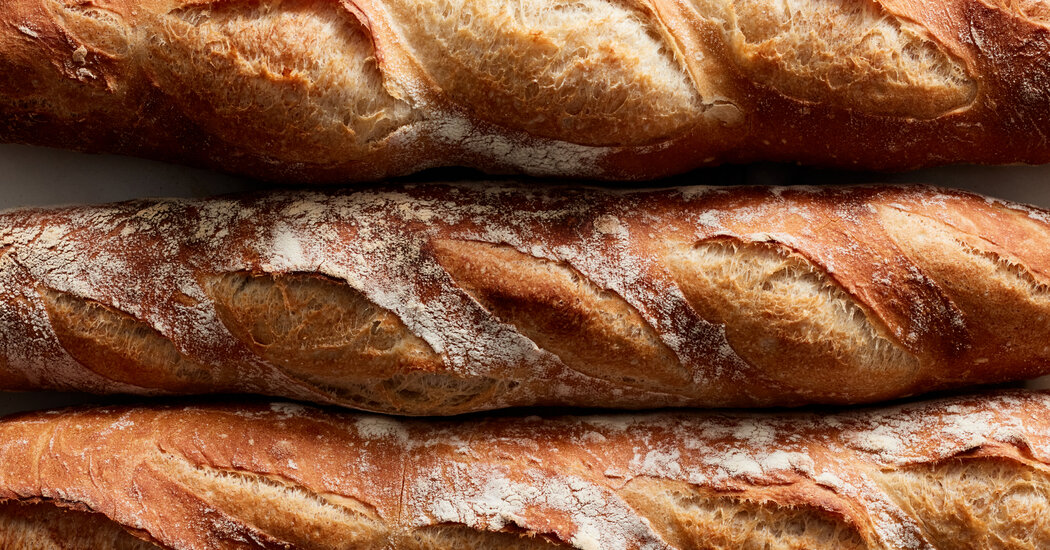
I know what many of you are going to say when I suggest making baguettes at home: “Why?”
I hear you. Really. If you happen to live near a top-notch bread bakery, or if you just don’t enjoy time in the kitchen, it may not be worth the effort. But I know many others — those who, like me, find project baking an exciting and productive way to spend part of a weekend — will be amazed at how fun and rewarding the process can be.
Among technical breads, baguettes are well suited for home baking because they’re typically made with commercial yeast rather than sourdough starter. This means there’s no maintaining a starter and feeding it in advance before you can start. In fact, the entire ingredient list couldn’t be simpler: flour, water, yeast, salt.
With so few ingredients, a successful baguette, with a thin, ultra-crisp crust and holey, creamy-tasting interior, hinges on flour selection. You want a flour that will facilitate enough gluten development to trap gas produced by the yeast to create interior holes of varying sizes, but not so much that the dough has a hard time extending into its hallmark long, thin shape. This means using flour with a 10 to 12 percent protein content (check the side of the bag for this information). At 11.7 percent, King Arthur all-purpose flour is a good, widely available choice, and it contains a little bit of barley malt, which enhances fermentation and flavor.
Because the final dough should be strong but not too strong, the mixing isn’t too intense and can be done by hand. You actually want to leave the dough a little underdeveloped, meaning it won’t feel particularly smooth or elastic after mixing: A series of folds performed as the dough rises (or bulk fermentation) will encourage the gluten development. By the end, the dough will feel strong, smooth and much less sticky.
If the ingredient list and mixing are relatively straightforward, acquiring the necessary equipment to make well-formed, classic-looking baguettes is more of a challenge. Two items — a 4-by-20-inch wooden transfer peel for gently moving the delicate loaves and a 13-by-20-inch wooden board for sliding them into the oven — require a little planning. Both can be bought online from specialty baking sites, or you can visit a hardware or home improvement store and have pieces cut from ¼-inch plywood. I opted for the second option, which set me back about $10. In place of the board, you could use a rimless baking sheet or a pizza peel, but make sure it’s at least 18 inches long and 12 inches wide to accommodate the loaves.
Also crucial are a lame and a large baking stone. A lame, a curved razor blade attached to a handle, slashes cleanly through the soft dough so it expands evenly in the oven. You can find one at well-stocked kitchen stores and online, though a utility blade from the hardware store makes a decent substitute. A baking stone radiates heat up and into the dough, helping the loaves rise rapidly and bake to a burnished finish. You could bake the loaves on a large upside-down baking sheet, but you won’t get the same results.
Once you have all the equipment, plan your timeline. The dough rests overnight in the refrigerator, which helps improve the bread’s flavor and the quality of the crust, while also affording you some flexibility. Start by making the poolish (a type of preferment, like sourdough starter but made with store-bought yeast) in the morning on the first day, mix the dough in the evening, refrigerate it overnight and bake at your convenience the next day. The recipe makes three baguettes, but if you don’t want to bake them all at once, you can return a portion of the dough to the refrigerator and bake it later.
Handling baguette dough, which is soft and a little sticky, can be tricky. Try to use a light touch and minimal flour during shaping, and know that the first dozen or so baguettes that you make at home might not be picture-perfect. Fortunately, a wonky baguette will still taste great, and I doubt anyone will care when they tear through the crackly crust.
While this may not have persuaded many casual home cooks to try their hand at baguettes, I know there are intrepid bakers out there who are already taking out their kitchen scales. If you’re in that group, congratulations — you’re soon to be richly rewarded.



